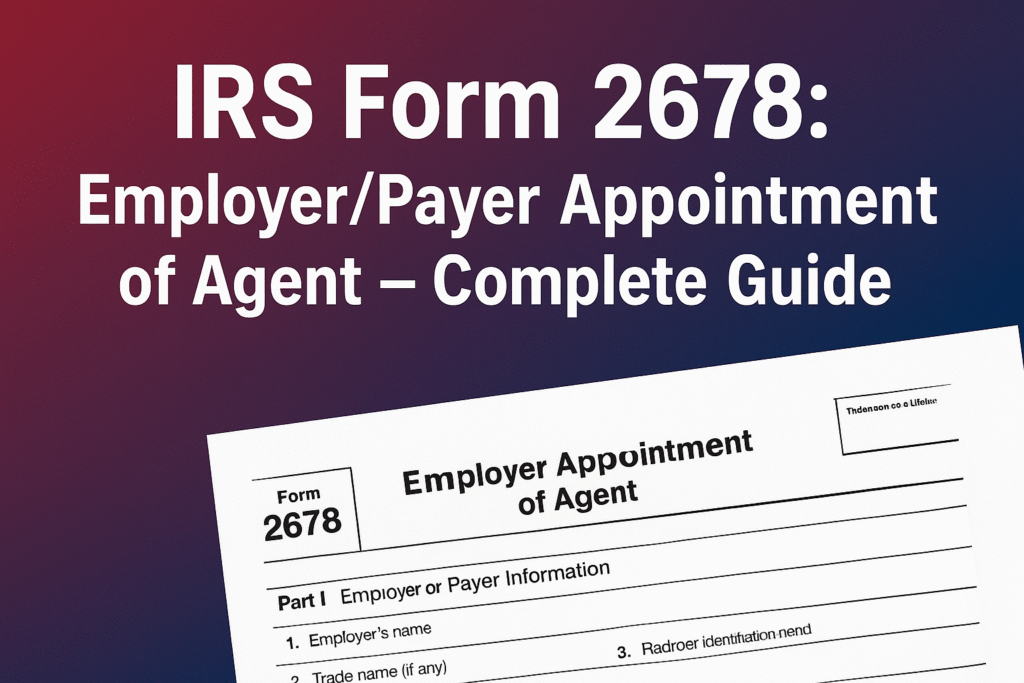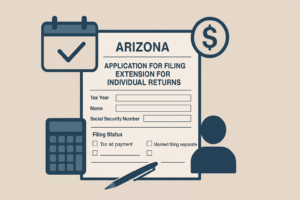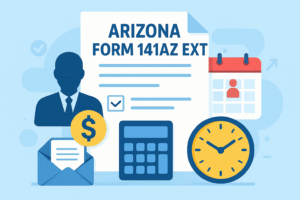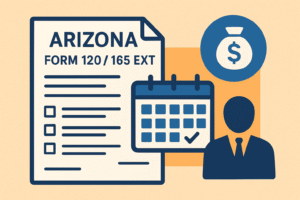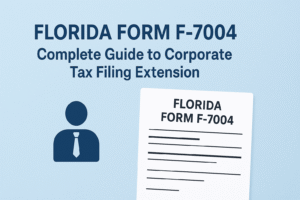Managing payroll taxes and compliance with IRS requirements can be overwhelming, especially for employers with complex workforce structures. To simplify the process, the IRS provides Form 2678 (Employer/Payer Appointment of Agent), which allows an employer or payer to officially appoint an agent to handle certain tax responsibilities on their behalf. This form plays a crucial role in ensuring proper reporting, payment, and communication with the IRS while reducing administrative burdens on businesses.
In this guide, we’ll break down everything you need to know about Form 2678—who must file it, the role of the authorized agent, how to complete it line by line, where to file it, and how long the authorization remains valid.
What Is Form 2678?
Form 2678, officially titled Employer/Payer Appointment of Agent, is an IRS authorization form that allows an employer or payer to appoint an agent—such as a payroll service provider, professional employer organization (PEO), or reporting agent—to take responsibility for certain federal tax obligations.
The authorization covers a wide scope of employment-related and withholding taxes, including:
- Federal Insurance Contributions Act (FICA) taxes – Social Security and Medicare taxes withheld from employees’ wages and matched by employers.
- Railroad Retirement Tax Act (RRTA) taxes – Special payroll taxes applicable to employers and employees in the railroad industry.
- Income Tax Withholding (ITW) – Federal income tax withheld from employees’ wages.
- Backup Withholding – Federal income tax withholding on non-wage payments, such as pensions, annuities, gambling winnings, retirement distributions, and independent contractor payments reported on Form 945.
By filing Form 2678, employers delegate responsibility for filing returns (e.g., Forms 941, 940, 943, 944, 945, CT-1, and CT-2), making deposits, and responding to IRS notices. However, while the agent manages compliance, the employer remains ultimately liable for any tax deficiencies or penalties.
Who Must File Form 2678?
You should file Form 2678 if:
- An employer wishes to appoint an agent (such as a payroll service, PEO, or third-party administrator) to handle federal tax filings.
- A payroll or reporting agent needs official authorization to interact with the IRS for a client.
- Home care service recipients (household employers paying caregivers) want to authorize an agency or another party to manage taxes for their workers.
- Special entities (e.g., railroads, nonprofits, government units) need an agent to ensure compliance with IRS tax requirements.
Note: Even when an agent is authorized, the IRS holds the employer ultimately responsible for tax compliance.
Role of Form 2678 Authorization Agent
The appointed agent’s role may include:
- Tax Return Filing – Preparing and submitting:
- Form 941 (Quarterly Federal Tax Return)
- Form 940 (Annual FUTA Return)
- Form 943 (Agricultural Employers)
- Form 944 (Annual Return for small employers)
- Form 945 (Annual Return of Withheld Federal Income Tax)
- Form CT-1 (Railroad Retirement Tax Return under RRTA)
- Form CT-2 (Employee Representative’s Railroad Tax Return)
- Tax Deposits and Payments – Making timely deposits via EFTPS to cover:
- Deposit withheld federal income tax (ITW).
- Deposit FICA (Social Security and Medicare) taxes.
- Deposit RRTA taxes for railroad employers.
- Deposit backup withholding for non-payroll payments reported on Form 945.
- IRS Communication – The IRS often sends notices regarding employment tax compliance, late deposits, or discrepancies. Form 2678 authorizes the agent to:
- Receive copies of IRS correspondence
- Address and resolve IRS inquiries directly
- Represent the employer in tax-related matters (within the scope of employment and withholding taxes)
This prevents delays in resolving issues and reduces the employer’s administrative workload.
- State and Local Returns – While Form 2678 primarily applies to federal employment and withholding taxes, it can also extend to certain state and local tax filings if the arrangement includes those responsibilities. Employers should clarify the scope of authorization with the agent before filing.
How to Complete Form 2678 (Line-by-Line Instructions)
Filling out Form 2678 is relatively straightforward but requires accuracy. Here’s a step-by-step guide:
Part I – Employer or Payer Information
- Lines 1–5: Employer’s name, trade name (if any), EIN, address, and telephone number.
- Line 6: Type of employer (corporation, partnership, sole proprietorship, nonprofit, household employer).
Part II – Agent Information
- Lines 7–11: Agent’s legal name, trade name, EIN, address, and contact details.
- Line 12: State the relationship (e.g., payroll service provider, PEO, reporting agent).
- Home Care Service Recipient Checkbox: Must be checked if the filer is a home care recipient authorizing an agent.
Part III – Authorization of Agent
- Check Boxes: Select the specific authorizations being granted:
- Filing federal employment and withholding tax returns (941, 940, 943, 944, 945, CT-1, CT-2)
- Making deposits and payments
- Receiving IRS notices and correspondence
- Separate Home Care Service Recipient Checkbox – confirm authorization if applicable.
- Additional Scope: Note if state/local filings are authorized.
Part IV – Signatures
- Employer Signature (or payer/home care recipient).
- Agent Signature to accept authorization.
How to File Form 2678
- Fill out accurately with all employer and agent details.
- Ensure both employer and agent signatures are provided.
- Mail the completed form (cannot be e-filed).
Where to Mail Form 2678
Mail to the IRS office assigned to the employer’s location:
| If your principal place of business, office, or agency is located in… | Address to mail Form to IRS |
| Connecticut, Delaware, District of Columbia, Georgia, Illinois, Indiana, Kentucky, Maine, Maryland, Massachusetts, Michigan, New Hampshire, New Jersey, New York, North Carolina, Ohio, Pennsylvania, Rhode Island, South Carolina, Vermont, Virginia, West Virginia, Wisconsin | Department of the Treasury Internal Revenue Service Kansas City, MO 64999 |
| Alabama, Alaska, Arizona, Arkansas, California, Colorado, Florida, Hawaii, Idaho, Iowa, Kansas, Louisiana, Minnesota, Mississippi, Missouri, Montana, Nebraska, Nevada, New Mexico, North Dakota, Oklahoma, Oregon, South Dakota, Tennessee, Texas, Utah, Washington, Wyoming | Department of the Treasury Internal Revenue Service Center Ogden, UT 84201 |
| If no legal residence or principal place of business in any state, use the following address: | Department of the Treasury Internal Revenue Service Center Ogden, UT 84201 |
| If you are filing Form 941 for an exempt organization or government entity send your Form 2678 to the following address: | Department of the Treasury Internal Revenue Service Center Ogden, UT 84201-0046 |
Always confirm with the latest IRS Form 2678 instructions for the correct address, since mailing addresses vary and may change over time.
How Long Is Form 2678 Valid For?
- Remains valid until revoked by either party.
- Employers revoke by written notice to the IRS.
- Agents may also withdraw by notifying both employer and IRS.
- A new Form 2678 is required when changing agents.
Final Thoughts
Form 2678 is an essential IRS document for employers, household recipients, and industries like agriculture and railroads. It authorizes an agent to file, deposit, and respond to IRS notices for employment and withholding taxes, including FICA, RRTA, ITW, and backup withholding obligations.
Employers should carefully complete the form, especially checking the right boxes in Part II and Part III, including those for home care recipients, to ensure authorization is correctly granted. While the agent handles the work, the employer remains accountable for accuracy and compliance.
By using Form 2678 correctly, employers can streamline compliance, avoid missed deadlines, and focus on running their business with peace of mind.

